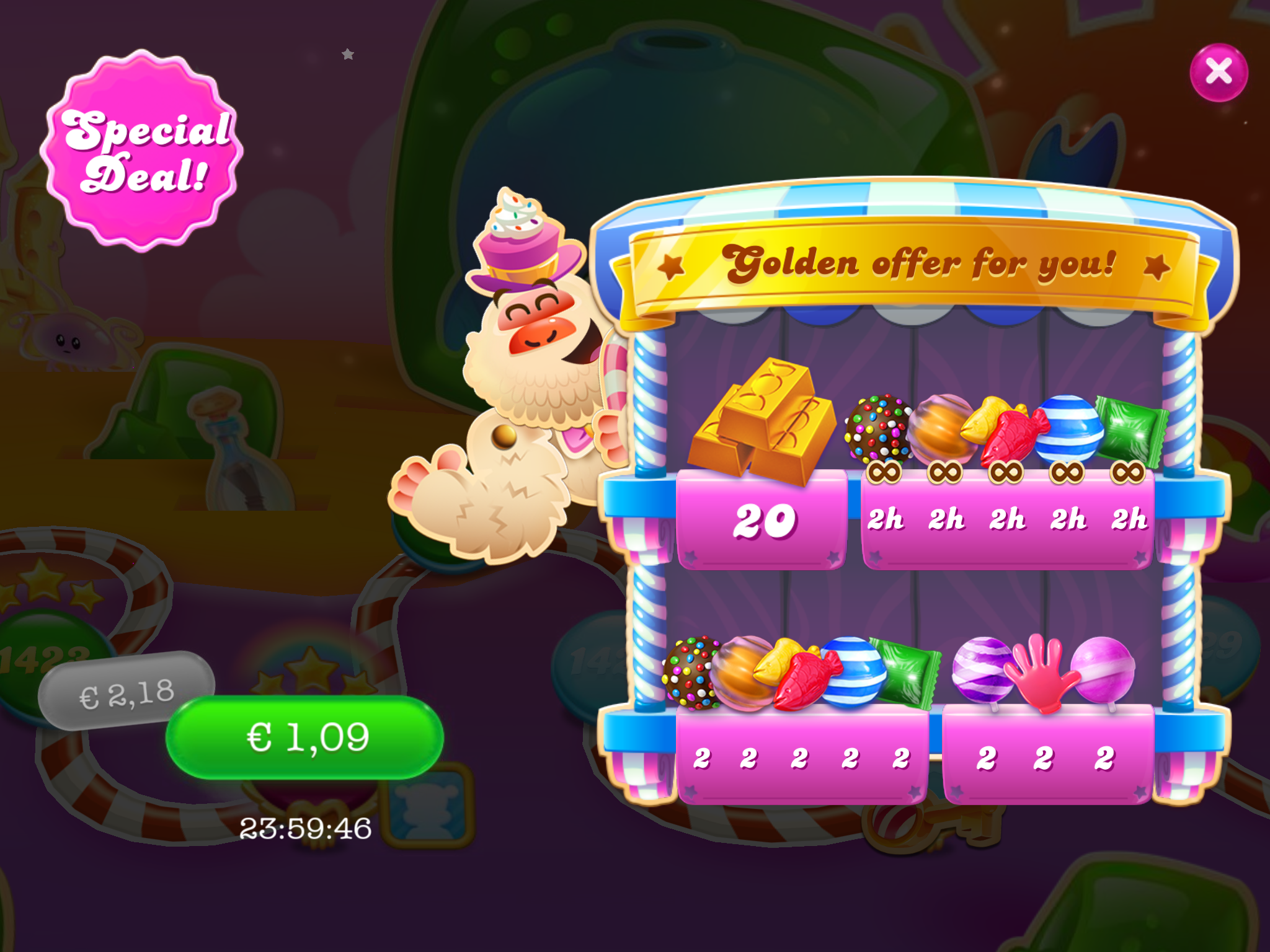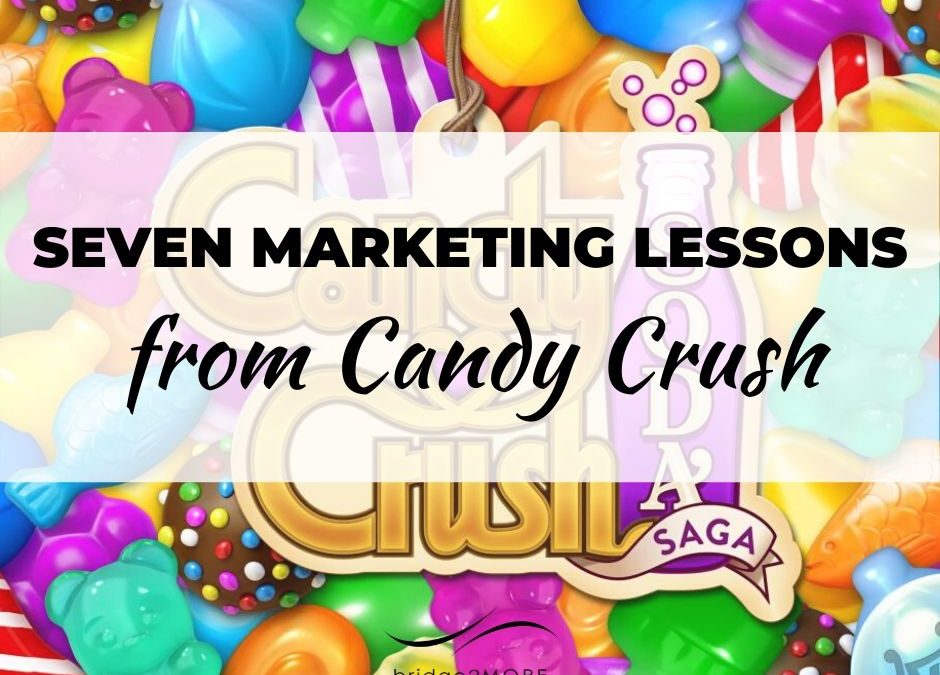The dynamics of Candy Crush are pretty similar to those of online marketing, though people seem to play the game better than they do understand marketing. Candy Crush gives us seven marketing lessons that will ease the learning curve.
The game:
Candy Crush Saga is a free-to-play match-three puzzle video game released by King in 2012. Five years after its release on mobile, the Candy Crush Saga series has received over 2.7 billion downloads, and the game has been one of the highest-grossing and most-played mobile apps in that time frame. King has since released three related titles, Candy Crush Soda Saga, Candy Crush Jelly Saga, and Candy Crush Friends Saga, and the craze continues.
- In the game, players complete levels by swapping coloured pieces of candy on a game board to make a match of three or more of the same colour, eliminating those candies from the board and replacing them with new ones, which could potentially create further matches.
- Matches of four or more candies create unique candies that act as power-ups with larger board-clearing abilities.
- Boards have various goals that must be completed within a fixed number of moves or limited amount of time, such as a certain score or collecting a specific number of a type of candy.
1-Goal, Strategy & Tactics
There are several objectives with each board: save the bears, pop bottles, eat the gum, spread the jelly, etc. That is the goal. How you play it is the strategy: create fish candies, combine fish with stripped candies and so forth. How you move the candies on the board to create the necessary special candies are the tactics.
Every time you play a given level you get a different layout as the candies never fall in the same sequence, still it’s the same level and the objective remains unchanged: save the bears, spread the jelly, pop the bottles etc. So while it seems it has changed, the basics remain unchanged.
You can compare that with the constant changes in the market because of the appearance of new tools, platforms etc. still if you are clear what you goal is, you look for ways to get there, even if the lay out changes.
If you do not pay attention to the strategy needed in that level, your chances to win slim down. So if you need to do fish and you do not bear that in mind, you run the risk of not playing in such a way that you create plenty fishes while you move the candies
In marketing, the goal is your business goals, the strategy is how you will achieve them and tactics are what link your strategy to your goals. Even if things change (new platforms, new gurus, new products or services you may develop) you still need goals, strategy & tactics, otherwise you don’t stand a chance to win the game.
2-Resources
The game offers a variety of resources in the form of daily bonus, boosters, special candies etc, that when played well remove candies and blockers off the board and help you to achieve the goal.
Sometimes boosters stand in the way, like on a level where at starting point you have only one move possible and it usually implies using the booster at a time it will not be of help.
This happens in marketing when we have resources that we do not know how to use or use in a less efficient way, or do what guru’s tell you to do without taking the time to play to our strengths, even if it seems counter-intuitive.
In Candy Crush you can combine resources for enhanced effects. Well, you guessed it. The same thing applies to marketing. For instance: to enhance traffic to you most recent blog, you combine postings on different social media, apply SEO to your content and make sure it is relevant to your audience.
When the different elements available to boost traffic are not coordinated, it’s like using the booster when they are of no use.
You can’t expect the special candies to do all the work. You still have to play the game to complete it. Back to the traffic example above: you can have the best content in the world, but if you do not optimise and distribute it, you’ll get no traffic.
3-The Corners
Usually the hardest part of the game, when candies fall downwards, is freeing the bottom or the corners. If you do not have enough moves to complete the level you lose a life and have to start again. Exactly the same thing happens with your marketing foundations, they are the cornerstone of your marketing game. If you do not get them right, by the time you realise it, you have spent valuable time in courses and shiny objects or gurus that were dangling the carrot at the top, and led you nowhere.
4-Obstacles & Hard Levels
To complete a level you need to remove obstacles: ice, honey, licorice. You move one by one, and as you do, the final pieces show up. In marketing, you start with solid foundations to build your game, and as you move forward, the game opens and shows you the opportunities. But you still have to remove the obstacles (procrastination, positioning, message etc) to be able to stay in the game and compete it.
When there are no combinations possible on the board, but you still have moves, the candies are shuffled so that you can continue playing. When you are stuck in your marketing game, look for what is keeping the progress locked, then shuffle it. Look at the gaps in your marketing. It may be your content, your message, the clients you are aiming at, for instance.
Some levels are hard, and when you have unlimited lives you keep playing, losing every round. At times, in Candy Crush, the more you insist continuously with a level, the more stubborn the layout, making it very difficult to win. When you stop playing, rest your eyes, and resume after a while usually the game plays out nicely. In marketing every so often when what you do is not delivering results, you need to take a step back and look at your marketing game with fresh eyes
Some levels are harder than others. But if you look at what is that you need to do to complete it and keep trying, noticing where you can improve, you finish it and can move on.
In marketing some things will come to you easily while others will require more effort. Being perseverant and regularly checking what you goal is and if you are doing what you have to do, will get you there. If your strategy relies on content, then you need to make sure that you are being consequent, perseverant and creating the right content for your goals.
5-Time-Bound Offers

Every so often Candy Crush pops a window offering to buy all the boosters for peanuts. You get 2hrs of unlimited boosters for about 1euro. But guess what, you still have 5 lives to play with.
You may argue that with so many resources you will not lose lives and be able to use the resources within the time allotted. But as you read above, resources may at times behave like obstacles.
In marketing we call that the shiny object syndrome plus FOMO (fear of missing out). We fall into the trap of buying the last invention, the most recent gadget/app/course, thinking that is the part we are missing in our game, and want to make use of the discount. Keep reading.
6-Game Previews
When a level has more stages, the game offers a preview. Then you know how to use your resources, you know where you are and where you are headed to. In marketing we call it context.
When you have context around something, you have a larger, more telling picture. It’s about those little details that help lend more clarity to things that would otherwise be pretty general and irrelevant.
In other words: context makes your marketing go the extra mile, which in turn, boosts your bottom line.
Also,let your tribe know the product and fall in love with it over and over again. Offer your clients different venues to get to know you and your services. A blog is a wonderful way to do so (and also helps to build authority), combine your blogs with webinars or mini courses, support your sales pages with testimonials, give your subscribers unique content and previews, create opportunities from them to get to know you and your services.
7-Chain Reaction Effect
 I once won 1million points in a game. Somehow everything on the board combined in such a way that I got a chain reaction that looked more like fireworks on New Year ’s Eve than a Candy Crush board.
I once won 1million points in a game. Somehow everything on the board combined in such a way that I got a chain reaction that looked more like fireworks on New Year ’s Eve than a Candy Crush board.
That is viral effect in marketing. Very hard to get, very hard to replicate, and result of the fortunate alignment of the sun the moon and the starts, or in this case, special candies.
That said, some chain reactions can be replicated very easy.
When you play well and win the level you get recognition: keep a life, get extra thingies like rainbow streak, which give you additional special candies, that automatically come into play in your next game. You win the game, you get to keep the booster and get another one with more special candies.
At some point your board is so full with special candies that with one move you get to complete the game, thanks to a chain reaction. That is referral marketing.
You play your marketing game well. Have your foundations in place, deliver on your promise, provide a superior experience, clients start to refer you, and your business grows like a chain reaction.
Contrary to what many people think, referral marketing is not an accident. Is a well thought out part of your strategy, and you need to bear it in mind as you begin the game.
Marketing isn’t that difficult. It’s like a game: you need to be clear what is the goal of the game, align your resources to best make use of them, don’t get distracted by shiny objects and FOMO, stick to your plan and, last but not least, play the game.






